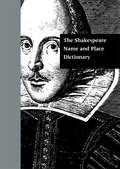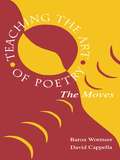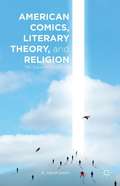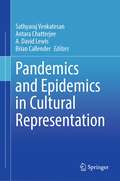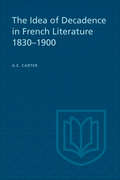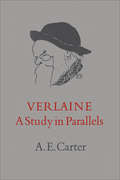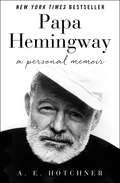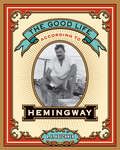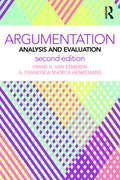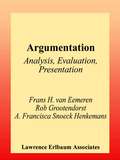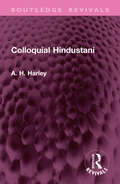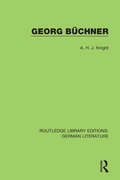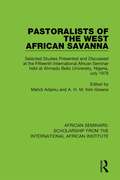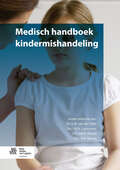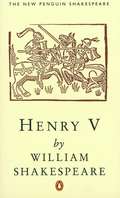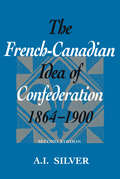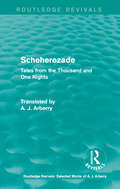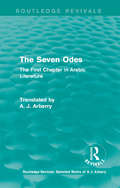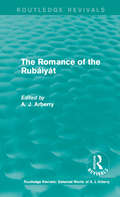- Table View
- List View
The Shakespeare Name and Place Dictionary
by A. Daniel Frankforter J. Madison DavisEntries provide the likely sources for a name; describe historical and mythological backgrounds; examine Shakespeare's presentation of a character or place; and suggest various interpretations of a name. Each entry contains line citations to William Shakespeare: The Complete Works, edited by Wells and Taylor, Oxford University Press, 1986.
Teaching the Art of Poetry: The Moves
by Baron Wormser A. David CappellaConcise and accessible, this guide to teaching the art of poetry from Shakespeare to contemporary poets enables anyone to learn about how poets approach their art. Teachers can use this book to explore any facet or era of poetry. Any reader can use it as an entryway into the art of poetry. Teaching the Art of Poetry shows poetry as a multi-faceted artistic process rather than a mystery on a pedestal. It demystifies the art of poetry by providing specific historical, social, and aesthetic contexts for each element of the art. It is a nuts-and-bolts approach that encourages teachers and students to work with poetry as a studio art--something to be explored, challenged, assembled and reassembled, imagined, and studied--all the things that an artist does to present poetry as a search for meaning. This book advocates poetry as an essential tool for aesthetic, cultural, and linguistic literacy. It portrays poetry as an art rather than a knowledge base, and methods for integrating the art of poetry into the school curriculum. The authors' intention is not to fill gaps; it is to change how poetry is presented in the classroom, to change how it is taught and how students think about it. Teaching the Art of Poetry: * Emphasizes hands-on experiences. Over 160 exercises focus attention on the dynamics of the art of poetry. Activities include group work, peer editing, critical thinking skills, revising drafts, focused reading, oral communication, listening skills, and vocabulary, as well as mechanics and usage. * Features a week-long lesson plan in each chapter to aid the teacher. These relate the main aspects of each chapter to classroom activities and, in addition, include a "Beyond the Week" section to promote further investigation of the topic. * Promotes an integrated approach to poetry. The examples used in each chapter show poetry as a living tradition. * Makes extensive use of complete poems along with extracts from many others. * Does not talk down to teachers--is teacher oriented and jargon free.
American Comics, Literary Theory, and Religion
by A. David LewisUnlocking a new and overdue model for reading comic books, this unique volume explores religious interpretations of popular comic book superheroes such as the Green Lantern and the Hulk. This superhero subgenre offers a hermeneutic for those interested in integrating mutiplicity into religious practices and considerations of the afterlife.
Pandemics and Epidemics in Cultural Representation
by A. David Lewis Sathyaraj Venkatesan Antara Chatterjee Brian CallenderThis edited book analyses how artists, authors, and cultural practitioners have responded to and represented episodes of epidemics/pandemics through history. Covering a broad range of notable epidemics/pandemics (black death, cholera, Influenza, AIDS, Ebola, COVID-19), the chapters examine the cultural representations of epidemics and pandemics in different contexts, periods, languages, media, and genres. Interdisciplinary in nature and drawing on perspectives from medicine, literature, medical anthropology, philosophy of medicine, and cultural theory, the book investigates and emphasizes the urgent need to reflect on past catastrophes caused by such outbreaks. By delving into cultural history, it re-examines how societies and communities have responded in the past to species-threatening epidemics/pandemics. Sure to be of interest to lay readers as well as students and researchers, this work situates epidemics and pandemics outbreaks within the contexts of culture and narrative, and their complex and layered representation, commenting on intersections of contagion, culture, and community. It offers a cross-cultural, global, and comparative analysis of the trajectories, histories and responses to various epidemics/pandemics that impacted people worldwide.
The Cambridge Companion to T. S. Eliot
by A. David MoodyAn international team of leading T. S. Eliot scholars contribute studies of different facets of the writer's work to build up a carefully coordinated and fully rounded introduction. Five chapters give a complete account of Eliot's poems and plays, while others assess the major aspects of his life and thought. Later chapters place his work in historical perspective. There is a full review of Eliot studies, and a useful chronological outline. Taken as a whole, this Companion comprises an essential handbook for students and readers of T. S. Eliot.
Printers Without Borders
by A. E. B. ColdironThis innovative study shows how printing and translation transformed English literary culture in the Renaissance. Focusing on the century after Caxton brought the press to England in 1476, Coldiron illustrates the foundational place of foreign, especially French language, materials. The book reveals unexpected foreign connections between works as different as Caxton's first printed translations, several editions of Book of the Courtier, sixteenth-century multilingual poetry, and a royal Armada broadside. Demonstrating a new way of writing literary history beyond source-influence models, the author treats the patterns and processes of translation and printing as co-transformations. This provocative book will interest scholars and advanced students of book history, translation studies, comparative literature and Renaissance literature.
The Idea of Decadence in French Literature, 1830-1900 (University of Toronto Romance Series #3)
by A. E. CarterThe cult of decadence is usually dismissed as an eccentricity of French literature, a final twitter of Romantic neurosis, convulsing the lunatic fringe of letters during the last third of the nineteenth century. However, the nineteenth century's preoccupation with decadence provides us with a key to the secret places of its thought, to all the obscure passages and backstairs behind the triumphant façade. Between 1814 and 1914, there was no sense of disaster, no tragic sense. Civilization had become a habit, a side product of political constitutions and applied science. History was viewed pragmatically: of what use were such traditional symbols as throne and altar? Both are essentially propitiatory, evidence of man's uneasy knowledge that power is dangerous and destiny implacable. And both seemed anachronisms in a world where (it was thought) human reason had solved or would solve all the old problems. The theory of decadence is very largely a protest against this comfortable belief. Had the decadents not written, we should hardly suspect that the nineteenth century suffered from the same doubts and hesitations as all other ages, before and since.
Verlaine: A Study in Parallels
by A. E. CarterThe contradictions of Verlaine's nature are mirrored in his verse, which is alternately mystic, sensuous, exquisite and prosaic. He had extraordinary lyric powers; he was a master of eerie harmonies such as few other poets have achieved, and, in Sagesse, he produced religious verse which challenges comparison with the very best of its kind. Yet here and there can be found a curious weakening in the texture of thought and inspiration: he turns and twists, takes flight, seeks reassurance in platitude and convention – marriage, dogmatic theology, reactionary political creeds. He is even capable of lamenting (as Rimbaud shows him in Une Saison en Enfer) the emotional and poetic experiments which give his work its supreme value. It is almost as though he were afraid of his own talent. The explanation, as far as there is one, lies in a combination of personality and circumstance. This biography attempts to explore the "parallels" (Verlaine's own term) between his life and his poetry. Nearly everything he produced, whether good or bad, was a reflection of some crisis of thought or feeling. No one demonstrates better than Verlaine the antinomies between the artist and his work, between the man and the genius; and in every case we are obliged to admit that the one explains the other. Without the weakness and the squalor we might indeed have had a rational human being and a good husband for Mathilde Mauté, but we should have had no poet, or no poet like Paul Verlaine. Professor Carter concentrates on the combination of Verlaine's personality and experiences that produced some of the most brilliant poetry in the French language. The result is one of the best critical biographies of Verlaine published to date.
Papa Hemingway: A Personal Memoir
by A. E. HotchnerAn intimate, joy-filled portrait and New York Times bestseller, written by one of Hemingway’s closest friends: “It is hard to imagine a better biography” (Life). In 1948, A. E. Hotchner went to Cuba to ask Ernest Hemingway to write an article on “The Future of Literature” for Cosmopolitan magazine. The article never materialized, but from that first meeting at the El Floridita bar in Havana until Hemingway’s death in 1961, Hotchner and the Nobel and Pulitzer Prize–winning author developed a deep and abiding friendship. They caroused in New York City and Rome, ran with the bulls in Pamplona, hunted in Idaho, and fished the waters off Cuba. Every time they got together, Hemingway held forth on an astonishing variety of subjects, from the art of the perfect daiquiri to Paris in the 1920s to his boyhood in Oak Park, Illinois. Thankfully, Hotchner took it all down. Papa Hemingway provides fascinating details about Hemingway’s daily routine, including the German army belt he wore and his habit of writing descriptive passages in longhand and dialogue on a typewriter, and documents his memories of Gertrude Stein, F. Scott Fitzgerald, Martha Gellhorn, Marlene Dietrich, and many of the twentieth century’s most notable artists and celebrities. In the literary icon’s final years, as his poor health began to affect his work, Hotchner tenderly and honestly portrays Hemingway’s valiant attempts to beat back the depression that would lead him to take his own life. Deeply compassionate and highly entertaining, this “remarkable” New York Times bestseller “makes Hemingway live for us as nothing else has done” (The Wall Street Journal).
The Good Life According to Hemingway
by A. E. Hotchner“Scholars and [fans] will delight . . . provide[s] a window into the multifaceted mind of a literary giant. A tasty bonus is roughly 150 mostly rare pix.” —Library JournalIn the fourteen years that A. E. Hotchner traveled with Ernest Hemingway, he collected a lifetime's worth of Hemingway's experiences, anecdotes, and observations on the backs of matchbooks, napkins, and slips of paper. Speaking on everything from war to women to writing, Hemingway's words are at turns funny and poignant, revealing a rich portrait of the American literary giant and the world he took by storm.Complete with black-and-white photographs that cover nearly two decades of Hemingway's life, The Good Life According to Hemingway is an exuberant celebration of his remarkable genius and the chaotic adventure of his life.“[E]ntertaining.” —Publishers Weekly
The Works of John Dryden: De Arte Graphica and Shorter Works, Volume XX
by John Dryden A. E. Wallace MaurerPresents six pieces written during Dryden's final decade. Two are translations, three introduce translations made by others, and the sixth introduces an original work by one of Dryden's friends.
Arabic Literature to the end of the Umayyad Period
by T. M. Johnstone R. B. Serjeant A. F. L. Beeston G. R. SmithOriginally published in 1983, The Cambridge History of Arabic Literature was the first general survey of the field to have been published in English for over fifty years and the first attempted in such detail in a multi-volume form. The volumes of the History provide an invaluable source of reference and understanding of the intellectual, literary and religious heritage of the Arabic-speaking and Islamic world. This volume begins its coverage with the oral verse of the sixth century AD, and ends with the fall of the Umayyad dynasty two centuries later. Within this period fall major events: the life of the Prophet Muhammad, the founding of the Islamic religion, the great Arab Islamic conquests of territories outside the Arabian Peninsula, and their meeting, as overlords, with the Byzantine and Sasanian world. Contributors to this volume discuss an array of topics including the influences of Greeks, Persians and Syrians on early Arabic literature.
Argumentation: Analysis and Evaluation (Routledge Communication Series #8)
by Frans H. van Eemeren A. Francisca HenkemansThis book concentrates on argumentation as it emerges in ordinary discourse, whether the discourse is institutionalized or strictly informal. Crucial concepts from the theory of argumentation are systematically discussed and explained with the help of examples from real-life discourse and texts. The basic principles are explained that are instrumental in the analysis and evaluation of argumentative discourse. Methodical instruments are offered for identifying differences of opinion, analyzing and evaluating argumentation and presenting arguments in oral and written discourse. Attention is also paid to the way in which arguers attempt to be not just reasonable, but effective as well, by maneuvering strategically. In addition, the book provides a great variety of exercises and assignments to improve the student’s skill in presenting argumentation. The authors begin their treatment of argumentation theory at the same juncture where argumentation also starts in practice: The difference of opinion that occasions the evolvement of the argumentation. Each chapter begins with a short summary of the essentials and ends with a number of exercises that students can use to master the material. Argumentation is the first introductory textbook of this kind. It is intended as a general introduction for students who are interested in a proper conduct of argumentative discourse. Suggestions for further reading are made for each topic and several extra assignments are added to the exercises. Special features: • A concise and complete treatment of both the theoretical backgrounds and the practice of argumentation analysis and evaluation. • Crucial concepts from pragmatics (speech act theory, Grice’s cooperative principle) presented in a non-technical way; introducing the theory of verbal communication. • The first textbook treatment of strategic maneuvering as a way of balancing being reasonable with being effective • Exercises and assignments based on real-life texts from a variety of contexts.
Argumentation: Analysis, Evaluation, Presentation
by Frans H. van Eemeren A. Francisca Henkemans Rob GrootendorstThis book concentrates on argumentation as it emerges in ordinary discourse, whether the discourse is institutionalized or strictly informal. Crucial concepts from the theory of argumentation are systematically discussed and explained with the help of examples from real-life discourse and texts. The basic principles are explained that are instrumental in the analysis and evaluation of argumentative discourse. Methodical instruments are offered for identifying differences of opinion, analyzing and evaluating argumentation and presenting arguments in oral and written discourse. In addition, the book provides a great variety of exercises and assignments to improve the students' skill in presenting argumentation. The authors begin their treatment of argumentation theory at the same juncture where argumentation also starts in practice: The difference of opinion that occasions the evolvement of the argumentation. Each chapter begins with a short summary of the essentials and ends with a number of exercises that students can use to master the material. Argumentation is the first introductory textbook of this kind. It is intended as a general introduction for students who are interested in a proper conduct of argumentative discourse. Suggestions for further reading are made for each topic and several extra assignments are added to the exercises. Special features: * A concise and complete treatment of both the theoretical backgrounds and the practice of argumentation analysis and evaluation. * Crucial concepts from pragmatics (speech act theory, Grice's cooperative principle) presented in a non-technical way; introducing the theory of verbal communication. * Unique coverage of both oral and written presentation of arguments. * Exercises and assignments based on real-life texts from a variety of contexts.
The Linguistic Shaping of Thought: A Study in the Impact of Language on Thinking in China and the West
by A. H. Bloom Alfred H. BloomFirst published in 1981. Routledge is an imprint of Taylor & Francis, an informa company.
Colloquial Hindustani (Routledge Revivals)
by A. H. HarleyFirst Published in 1944, Colloquial Hindustani is intended to supply the beginner in the language not only with the common rules of grammar and their exemplification with sentences of a practical nature, but to assist him towards a correct pronunciation, with a phonetic system of spelling designed as part of an All-India system of romantic orthography.Hindustani, like Bengali, Marathi, Gujarati and most other Indian languages except those of the southeastern part of the peninsula has its ancient roots in Prakrit or ‘vernaculars’ associated with Sanskrit. The widespread common language Hindustani is closely associated with two specialised literary languages, Hindi and Urdu. The everyday speech of millions of people in the North of India is the expression of a common language, Hindustani. This little book makes a small beginning especially in the matter of Roman spelling and is an important historical reference work for students of linguistics and Indian languages.
Georg Büchner
by A. H. KnightOriginally published in 1951 this full length study gives an account of Büchner’s life and personality, together with an account of his three plays, his unfinished short story, his scientific publications and his translations of Hugo.
Pastoralists of the West African Savanna: Selected Studies Presented and Discussed at the Fifteenth International African Seminar held at Ahmadu Bello University, Nigeria, July 1979 (African Seminars: Scholarship from the International African Institute #1)
by Mahdi Adamu A. H. M. Kirk-GreeneOriginally published in 1986, this volume deals with various aspects of the life of the pastoralists who live in the area between what was Senegambia and Cameroon. It analyses the changing relations between pastoralists and agricultural peoples, and the changes that pastoral societies are undergoing with urbanisation, increased central government control and the spread of market relations. The papers are in both English and French and include historical studies of aspects of the history of Adamawa, the Fulani, the Twareg, the Shuwa Arabs and the Koyam in pre-colonial times. There is also a survey of the state of Fula language studies and the variety of Fula literature; discussions of the changing nature of pastoralism and the nomadic way of life in Cameroon, Senegal and Nigeria, including the effects of drought.
Medisch handboek kindermishandeling
by A. H. Teeuw E.M. van de Putte I.M.A. Lukkassen I.M.B. Russelhandboek voor brede doelgroep: kinderartsen, jeugdartsen, SEH-artsen en huisartsen over het signaleren en herkennen van kindermishandeling. De opbouw van ieder hoofdstuk zal als volgt zijn: terminologie, epidemiologie, diagnose, behandeling, casus.
Henry V
by William Shakespeare A. HumphreysShakespeare's immutable history of Henry's victory over the French at Agincourt and the subsequent peace between the two nations is also a study of war and kingship. From a wild youth, Henry comes to embody all of the kingly virtues: courage, justice, integrity and honour. Ironically these qualities are brought to the fore by the realities of war. Written at the end of the life of Elizabeth I, Henry V told the British people that with strong leadership, they had little to fear at a time of uncertainty.
The French-Canadian Idea of Confederation, 1864-1900
by A. I. SilverAt Confederation, most French Canadians felt their homeland was Quebec; they supported the new arrangement because it separated Quebec from Ontario, creating an autonomous French-Canadian province loosely associated with the others. Unaware of other French-Canadian groups in British North America, Quebeckers were not concerned with minority rights, but only with the French character and autonomy of their own province.However, political and economic circumstances necessitated the granting of wide linguistic and educational rights to Quebec's Anglo-Protestant minority. Growing bitterness over the prominence of this minority in what was expected to be a French province was amplified by the discovery that French-Catholic minorities were losing their rights in other parts of Canada. Resentment at the fact that Quebec had to grant minority rights, while other provinces did not, intensified French-Quebec nationalism.At the same time, French Quebeckers felt sympathy for their co-religionists and co-nationalists in other provinces and tried to defend them against assimilating pressures. Fighting for the rights of Acadians, Franco-Ontarians, or western Métis eventually led Quebeckers to a new concern for the French fact in other provinces.Professor Silver concludes that by 1900 Quebeckers had become thoroughly committed to French-Canadian rights not just in Quebec but throughout Canada, and had become convinced that the very existence of Confederation was based on such rights.Originally published in 1982, this new edition includes a new preface and conclusion that reflect upon Quebec's continuing struggle to define its place within Canada and the world.
Routledge Revivals: Tales from the Thousand and One Nights (Routledge Revivals: Selected Works of A. J. Arberry #1)
by A. J. ArberryFirst published in 1953, this translation of part of the Arabian Nights by A. J. Arberry offers four famous stories in modern idiom: Aladdin, Judar, Aboukir and Abousir, and the Amorous Goldsmith. The introduction provides a brief analysis of earlier translations of the tales and explains their value as indicators of the society in which they were written. This work will be of interest to those studying Middle-Eastern literature and history.
Routledge Revivals: The First Chapter in Arabic Literature (Routledge Revivals: Selected Works of A. J. Arberry #2)
by A. J. ArberryThese seven poems, translated by A. J. Arberry in 1957, are the most famous survivors of a vast mass of poetry produced in the Arabian Desert in the sixth century. Arberry’s introduction explains to the reader what was known about the poems and how they came to be preserved and distributed over time. The epilogue particularly interrogates the authenticity of the poems and tracks how they have been transmitted over time. This work will be of interest to those studying Persian and Middle-Eastern literature and history.
Routledge Revivals: The Romance of the Rubáiyát (Routledge Revivals: Selected Works of A. J. Arberry)
by A. J. ArberryFirst published in 1959, this reprint of the first edition of Edward FitzGerald’s translation of the Rubáiyát is accompanied by an introduction and notes by A J Arberry, one of Britain’s most distinguished Orientalist scholars. The Rubáiyát is a selection of poems written in Persian attributed to Omar Khayyám. The work will be of interest to those studying Middle Eastern Literature.
The Oxford Guide to Word Games
by Tony Augarde A. J. AugardeRiddles such as this are just one of the forms of linguistic gymnastics explored in this invaluable source-book. Unique in its thematic and historical approach to the subject, it will tell you everything you ever wanted to know about word games and wordplay, and is entertaining as well as informative. The Oxford Guide to Word Games quickly established itself as the authoritative work on the subject when it was first published in 1984. It not only described all the major word games but also traced their origins and placed them in their social context. Now thoroughly revised, enlarged, and updated to make it even more valuable and comprehensive, this edition includes several new chapters, covering topics such as homonyms and slips of the tongue. New material has also been added on many topics including crossword clues, blends, and kangaroo words. Book jacket.
